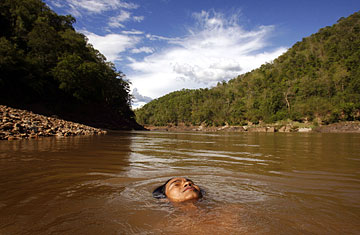
A 16-year-old Karen boy swims in the Salween River at the Myanmar-Thai border in May 2006
Living under the thumb of a brutal junta, the average Burmese hardly leads an easy life. But the plight of the country's ethnic minorities, many of whom once waged long and bloody insurgencies against the military regime, is even worse. As a new human-rights report released on Jan. 28, as well as the recent stories of destitute refugees who fled Burma attest to, members of Burma's ethnic groups face persistent discrimination by the military regime. They are the targets of unpaid forced labor campaigns, scorched-earth policies that destroy farmland and relocation programs that require entire villages to move at a moment's notice. (See pictures of Burma's 19 years of protest.)
Called Myanmar by its military leaders, Burma derives its name from the Buddhist Burman (or Bamar) people. The country's largest ethnic group, the Burman historically lived in Burma's central and upper plains. But this patchwork country of 55 million is made up of more than 100 unique ethnicities. The isolation enforced by Burma's numerous mountains and hills helped nurture these culturally discrete groups, making it one of the most diverse countries in Southeast Asia, despite its relatively small geographic size. Here are five ethnicities, some of who have unsuccessfully waged long insurgencies against the central government and others who have made news recently because of the abuses they have suffered at the hands of the Burman-dominated regime. (See pictures of tension in Burma.)
Rohingya
Perhaps the most exploited minority in Burma, the Rohingya are a Muslim group that has been refused citizenship by the Burmese government by the Burmese government since 1982 when the junta implemented a citizenship law. As a consequence, the stateless Rohingya, who number around 800,000 in western Burma and physically resemble Bengalis, are prime targets for forced-labor drives by the junta. Since the military took power in 1962, hundreds of thousands have fled to Bangladesh, Malaysia and Thailand, where their illegal-immigrant status makes them vulnerable to labor abuses.
In January, navy troops and fishermen in India and Indonesia discovered dozens of Rohingya boat people drifting in their countries' territorial waters. Some survivors alleged that their efforts to seek sanctuary in Thailand were thwarted by the Thai Navy, which forcibly herded them onto leaking boats without enough food or water and set them to sea. The survivors also claimed they were beaten by Thai forces — and that several of their fellow passengers were shot to death by the Thais. Although plenty of Rohingya have found illegal and low-paid work on Thai fishing fleets, the Thai government outwardly maintains a strict stance toward these would-be immigrants: On January 28th, Thailand convicted more than 60 Rohingya of illegal entry and announced they would be deported. (See pictures of Burma's discontent.)
Shan
Clustered in the northeastern hills of Burma, the Buddhist Shan were accorded a measure of self-rule by British colonialists. When Burma became independent in 1948, they agreed to join the fledgling nation in return for autonomy. But the promise, say Shan opposition groups, was never kept — and several militias were soon formed to fight against the Burmese army. Although a ceasefire was signed in the mid-90s by most Shan groups, the minority's resistance is still active in pockets. Over the past decade, forced relocations by the Burmese military of tens of thousands of Shan, who are thought in total to number at least 5 million, have garnered condemnation by international human-rights organizations.
Chin
Overwhelmingly Christian, the Chin live in the impoverished mountains near the India-Burma border. An armed wing of the Chin National Front, which was founded in 1988, is one of the few remaining forces waging an insurgency against the ruling junta, but it has been accused by human-rights groups of mistreating its own people. Like the Rohingya, the Chin claim the junta persecutes them in part because of their religious beliefs. Most Chin are American Baptists, having been converted by missionaries in the 19th century. Although tens of thousands of Chin are believed to have sought refuge in India since the junta came to power, the New York-based NGO Human Rights Watch claimed in a report released on Jan 28 that New Delhi has forcibly repatriated many Chin, essentially handing them back to their persecutors. (See pictures of the junta blocking Burma from receiving aid after a cyclone ripped through the country.)
Karen
The second-largest ethnic group after the Burmans, the Karen have also waged a long rebellion against the Burmese junta seeking either self-determination or even independence, depending on which insurgence group. Both Christian and Buddhist, the Karen have been plagued by internal strife between rival factions over the past couple of decades. A general ceasefire framework with the central government is in place but occasional flashpoints of fighting still occur. Karen villagers, who tend to live in the Irrawaddy Delta and in the border region between Burma and Thailand, have been victims of forced relocation and labor programs run by the Burmese military.
Kachin
Mostly Christians, the Kachin live in northern Burma and were famous during colonial times for their battle skills. Although they, too, waged a decades-long armed struggle against the Burman-dominated regime, the Kachin signed a ceasefire with the government in 1994. Despite a boom in forestry and casinos in Kachin State, quality of life for many Kachin remains poor, with forced-labor campaigns common, along with human-trafficking to nearby China.
